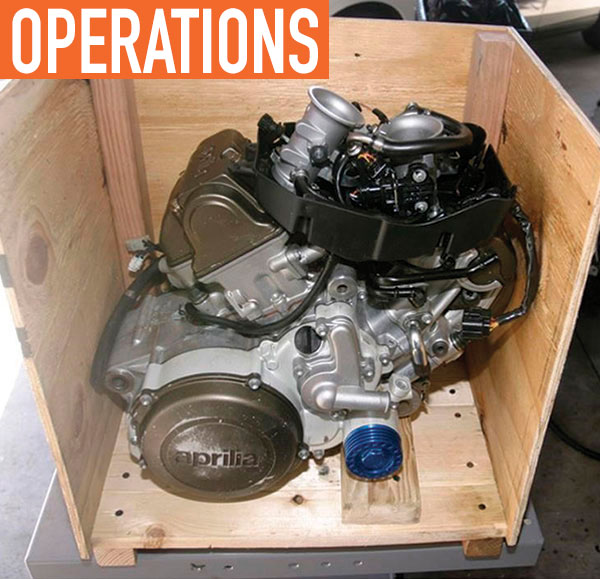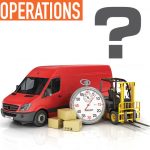No matter how well maintained your fleet of work trucks, sooner or later, you will be repairing or replacing an engine, transmission, or other primary power component. Oftentimes, this involves shipping the broken part out to a repair shop. While removing and reinstalling is second nature to your team of mechanics, the preparation and logistics of shipping are probably a foreign language to them. It doesn’t need to be that difficult if you follow some simple guidelines.
Most large equipment parts weigh more than 150 lbs. This means that they are too heavy to ship as a parcel, but will likely not occupy an entire truck; hence they will fall in the category of Less Than Load (LTL). LTL carriers have specific rules about the freight they carry. The nuances of engines, transmissions, and mechanical parts require special care to meet those requirements. Following the five steps below will make this dreaded task simpler and less expensive.
PREPARING A USED PART FOR SHIPMENT
Start by washing up the engine or transmission using a commercial degreaser combined with a power washer or a scrub brush and hose. It’s important that neither the engine nor its container look greasy and oily, because a carrier will refuse pick up if the package is leaking oil.
DRAIN OUT FLUIDS
The main concern of carriers is leakage of engine oil and other fluids. Make sure to completely drain an engine or transmission of all fluids and oils. You don’t have to jump through hoops to get out every last drop—carriers typically allow up to one quart to remain. Just make sure the dipstick indicates an empty oil reservoir.

Whether choosing crate or pallet, be sure to leave clearance for a forklift to handle your item.
PACK IT UP
Every engine and transmission is different and therefore, every packaging solution must be custom-tailored for safe and secure shipping. The two most popular methods of packaging an engine or transmission are on a pallet or in a wooden crate. Whichever you choose, it’s important to leave clearance for a forklift to handle your item.
Place the engine or transmission in the center of a pallet or bottom of the crate and block it with 2x4s and screws to make sure it is well supported. It is best to support the part on its mounting points, such as motor mounts, instead of letting it sit on the oil pan. If shipping on a pallet, secure it with industrial ratcheting straps, ropes, or chains. Make sure the component cannot shift or budge from the security of the pallet base during shipment.
LTL carriers will not accept engines and transmissions that are not completely concealed. Use cardboard and/or foam to cover the part and then shrink-wrap the entire unit together. The caveat to this is the carrier must have access to the fluid intakes on the component—they will check the dipstick to make sure the fluid is drained.
If you choose to ship your engine part in a wooden crate, be sure that it is securely fastened to the base of the crate, preferably with through bolts. The lid of the crate should be easily removable and replaceable, so that the carrier can check the dipsticks and inspect the freight as required.

Featured Image: If you choose to ship your engine part in a wooden crate, be sure that it is securely fastened to the base of the crate with an easily removable lid.
Above: ShipX can help you find the best, most affordable route to ship your engine or transmission.
BOOK YOUR SHIPMENT ONLINE
The easiest and best way to arrange for shipment is through an online LTL freight exchange, such as www.shipxfreight.com. Start by entering origin and destination address information. Next, you must accurately measure the outside dimensions of your package and weigh it to the nearest pound. It’s important to be accurate about the exact dimensions and weight, because the carrier will charge you if your freight is heavier or larger than you claim.
On any shipment, it is important to get price comparisons from various carriers. Carriers have “lanes” where they are most competitive in price, so depending on your destination, different carriers will emerge as the most competitively priced. ShipX provides you with quotes from leading LTL providers along with transit time and customer ratings for the carrier. You should evaluate all three aspects—price, transit time, and reputation of the freight carrier when making your choice.
When you have selected your carrier, you are on the home stretch. Enter payment information and create the Bill of Lading (BOL). Be sure to use the BOL ShipX provides and include as much detail as possible on the BOL. This will be attached to the shipment prior to departure. Keep your copies to prevent confusion or disagreement with the carrier over specifics.
DISPATCH, TRACK, RELAX
The ShipX system will automatically dispatch a truck from your carrier to pick up the load, then keep you posted on its progress all the way to its destination.
While there is some level of work and preparation required to ship an engine, transmission, or other large mechanical part, it need not be something to be feared or dreaded. Following these five steps will make the process relatively painless and will save you time and money, allowing you to concentrate on the core competencies of your business.
ABOUT THE AUTHOR:
Augie Grasis is the CEO of ShipX. Find out more about what ShipX has to offer, visit www.shipxfreight.com.
_______________________________________________________________________
MODERN WORKTRUCK SOLUTIONS: APRIL 2016 ISSUE
Did you enjoy this article?
Subscribe to the FREE Digital Edition of Modern WorkTruck Solutions magazine.
![]()




